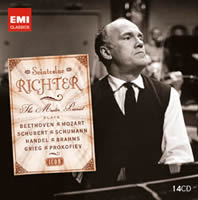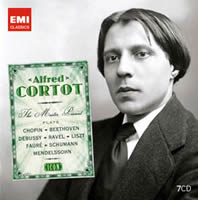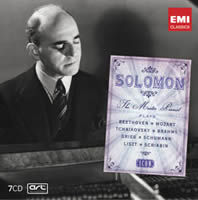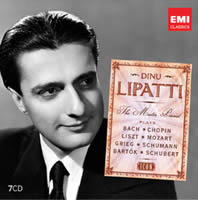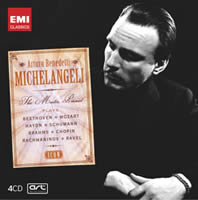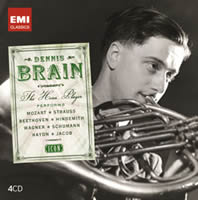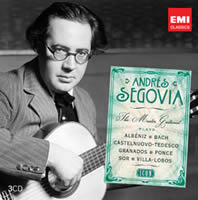Golden Oldies: EMI’s Icon Series — The Instrumentalists
|
Dan Davis [December 2008.] The big record labels often get bashed for their unending round of reissues, often repackaged into boxed sets to tempt collectors who already have half their contents. Worse, those reissues seem to have a shelf life of about 15 minutes, a here-today, gone-tomorrow marketing game that extends copyrights and maximizes returns from a catalogue sector that more than paid for itself years ago. There’s also the question of sonics. Vintage 78s and LPs can sound surprisingly fresh with today’s transfer technologies, but too often reissue programs simply recycle their last digital transfers of olde recordings, some of them dating from the 1980s when they were plagued with digititis and its attendant distortions. Still, which would you want in your collection, Heifetz or the latest post-pubescent fiddler’s over-hyped CD? Which brings me to EMI’s Icon Series, ambitious multi-disc boxed sets that restore to circulation the work of great musicians. It offers newbies the opportunity to hear transcendent artists at the top of their game and gives veteran collectors opportunities to plug gaps in their CD shelves. The first two releases of the Icon series are now out, and given the industry’s tendency to delete, here’s fair warning not to delay stockpiling those that interest you.
The biggest, most comprehensive Icon box is devoted to the complete EMI recordings of Sviatoslav Richter, 14 discs worth. Now, there’s no shortage of available Richter discs but if like me, you place him high in the pantheon of great pianists, it’s good to have his EMIs easily available. And relatively cheap, too. The Icons are going for a bit less than $7 per disc, small change for the wonders of Richter’s Schumann Fantasy, the Beethoven Tempest sonata, and Beethoven and Mozart violin sonatas with Oleg Kagan, among much else. Seven of the discs are solo recordings, including two CDs of Handel’s keyboard suites, alternating probing slow movements and graceful dance-based movements with scintillating faster ones. With Dietrich Fischer-Dieskau in Brahms’ Die Schöne Magelone song cycle, Richter elevates the piano part above its usual “accompanist” status, F-D is in good voice, but the booklet (shamefully) doesn’t include texts. The remaining six discs are good to excellent performances of concertos by Mozart, Beethoven, Brahms, Dvorak, and others, along with Berg’s wonderful but relatively rarely heard Chamber Concerto.
Alfred Cortot was one of those rare artists whose lyric gifts and Romantic sensibilities were allied to beautiful tone and individual, even idiosyncratic, interpretations, easily qualifying him for the Icon designation. This seven-CD set offers solo and chamber works and one recording as conductor — the Brahms Double Concerto with his partners in the Casals-Cortot-Thibaud Trio. All were recorded between 1923 and 1937, generally considered his prime years. Much has been made of his propensity to drop notes and commit other insults to modern dogmas of textual accuracy. But what are a few misplaced notes when measured against Cortot’s ability to penetrate the core of a work or the spontaneity that permeates the Chopin Préludes on the set’s first disc or the exhilarating Liszt program that ends it. For some, the set’s revelation will come from the collaborations with violinist Jacques Thibaud in sonatas by Franck, Debussy, and Fauré, elegant, deeply felt exemplars of the French style. The Trio recordings from the late 1920s — Beethoven, Schubert, Haydn, Schumann, Mendelssohn — have long held classic status and remain iconic remnants of an era when beautiful tone and poetry trumped machine-age slickness.
The British pianist Solomon Cutner, who performed under the single name Solomon, was synonymous with refined pianism. But don’t let words like “refined” or others usually employed in describing his playing, like “poised” or the deadly “aristocratic,” trick you into missing the fire that characterized his playing of the Romantic repertoire. Brahms’ Second concerto here glows fiercely when it’s supposed to but sings sweetly as well; so do the virtuosic Scriabin, Tchaikovsky, and Bliss concertos. Two of the set’s seven discs sample his great Beethoven performances of sonatas from the projected complete set halted by the stroke he suffered in 1956. They include six works including a marvelous Hammerklavier with its long slow movement played with concentrated intensity. Another disc couples the Third and Fifth concertos, while his famous Grieg and Schumann concertos still stand among the best on record. The mostly Mozart disc here will tempt you to keep it on “repeat,” so gorgeous is the playing, so natural and apt the phrasing. Solomon was a pianist of great technical polish but his virtuoso gifts were always placed at the service of the composer, leading some critics to call his performances “understated.” Not true; listen carefully and you’ll hear endless nuances of phrase, color, and timbre that illuminate the music. Alas, this set doesn’t include some of his best work, prime among them his great Chopin recordings. But take heart — you can find them on Testament SBT1030.
Dinu Lipatti, like Solomon, sparked automatic use of double-edged adjectives and he does play with an elegance that invites words like “refined.” But what is most distinctive about his pianism is a naturalness that makes you think “Oh, that’s how the piece should go,” rather than dwell on what’s especially different about the interpretation. That sense of rightness is evident throughout the seven discs of this set. His final 1950 Besançon recital is here, of course, with its incomparable Bach Partita No.1, Mozart Sonata, K. 310, a pair of exquisite Schubert Impromptus, and 13 of the 14 Chopin Waltzes. Ravaged by illness, he could not complete the Chopin set; a few months later, he was dead at age 33. Like rock stars, concert artists who die young assume mythical grandeur, but when they’re truly great, like Lipatti, they become icons. The discs here include beautifully paced and phrased Chopin — the B-minor Sonata, a lovingly sculpted Barcarolle, a studio recording of all 14 Waltzes, the D-flat Nocturne, a pair of Études, and the First concerto, the latter, like several selections here, taken from live concerts. Music of his contemporaries include Ravel’s Alborada del gracioso, Bartók’s Concerto No. 3, and Enescu’s Piano Sonata No. 3. File this one under “not to be missed.”
More marvels can be found in the four-disc Michelangeli box, covering his EMI studio recordings from 1939 to 1975. Michelangeli earned a reputation as an eccentric thanks to his regular concert cancellations, among other things, but the evidence of these discs surely confirms him as an icon of the piano. His spacious yet engrossing 1975 Schumann Carnaval substantiates critical murmurings about chilly playing while more relevantly confirming his virtuoso command and his ability to turn these pieces into an epic journey that entrances. While his Haydn concertos (also from 1975) are done with brilliance they tend to sound like messages from the North Pole in their frosty approach. But such reservations fall by the wayside when we hear Disc 4, which contains one of the analog era’s legendary LPs, a coupling of the Ravel G-minor Concerto with Rachmaninoff’s Fourth, as close to perfect performances as one could wish for, the Ravel’s slow movement nothing short of miraculous and its coruscating finale incomparably projected. The Mozart concertos here are outstanding, the slow movement of K.488 a highlight for its pure cantabile playing and endless dynamic shadings. Even in his earliest recordings we hear subtleties of execution that indicate supreme virtuosity made to sound easy, as in a 1942 Chopin B-minor Scherzo and the subtle tonal colorings of pieces by Mompou and Debussy. If the Brahms Paganini Variations seem odd, it’s because he made his own arrangements mixing the two books to suit his tastes, not exactly unknown among artists of previous eras. * * *
Along with the pianists, the Icon series includes three boxes devoted to undeniably great instrumentalists — Heifetz, Segovia, and Dennis Brain. The Heifetz Box of six CDs features a less chilly Jascha than we sometimes hear on his later RCAs, with a fabulous Disc 1 that unites the Sibelius, Tchaikovsky and Glazunov concertos with Beecham and Barbirolli conducting, 80 minutes of musical nirvana. Another disc, devoted to encore pieces, shows the master at his virtuosic best, an alchemist turning bon-bons into precious gems. And if you want to hear what a match of giants sounds like, there’s the Franck Sonata with Rubinstein and the Beethoven Kreutzer sonata with Moiseiwitsch! You might say Dennis Brain was the Heifetz of the French horn and the four-disc Icon box provides the evidence. Here are the classic Brain recordings from the mid-1950s: the two Strauss horn concertos with Sawallisch, the four Mozart concertos with von Karajan, the Hindemith concerto with the composer conducting, all with the Philharmonia in its glory days. Less likely to be in your collection are the Lennox Berkeley Trio and the Gordon Jacob Sextet, among others. There’s also a pair of Mozart concertos from the 1940s and another Strauss First from 1947. As for Segovia, that master should never be forgotten amid the current popularity of the guitar and its burgeoning crew of virtuosos, for the Spaniard virtually created the modern repertory for the instrument and his charismatic playing helped make the guitar “respectable.” The three-disc Icon set includes his EMI recordings made from 1927 to 1939 and 1949. The Castelnuovo-Tedesco Concerto No. 1, which Segovia commissioned, is the longest work here and among the most interesting. The rest of the set is made up of short pieces and transcriptions, all enjoyable, all confirming Segovia’s mastery of his instrument. More Icons to come in the next Golden Oldies: The Singers. Stay tuned.
[More Dan Davis]
[Previous Article:
Piano Factory 3.]
[Next Article:
Elliott Carter at 100]
|
